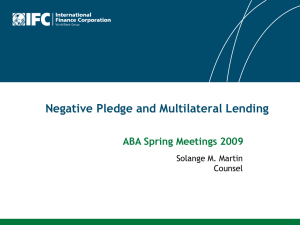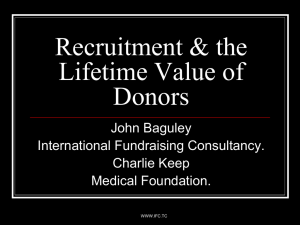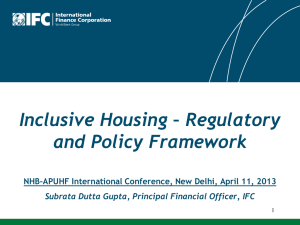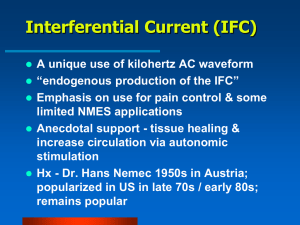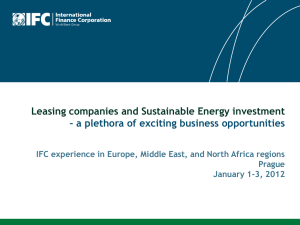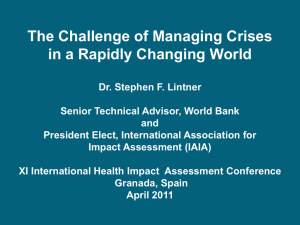Evaluating World Bank Group Support to the Private Sector
advertisement
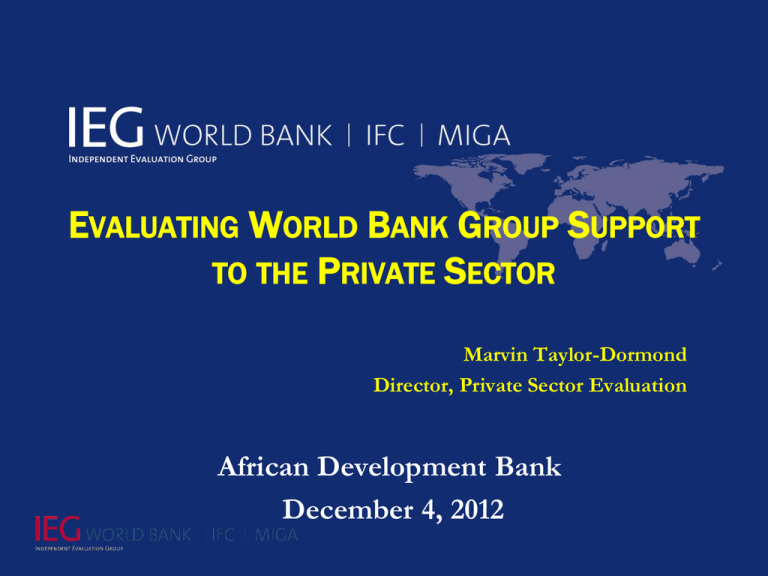
EVALUATING WORLD BANK GROUP SUPPORT TO THE PRIVATE SECTOR Marvin Taylor-Dormond Director, Private Sector Evaluation African Development Bank December 4, 2012 Key Topics PRIVATE SECTOR AND DEVELOPMENT 1. 2. 3. 2 Private Sector and Development: A key driving force Nature of WBG Operations in support for Private Sector Select Findings and Lessons at IFC from Micro and Macro Independent Evaluation Private Sector and Development Primary contributor to jobs, growth, innovation Often impeded by market and institutional failures Private Public interface is critical Role of International Development Agencies 3 WBG Activities in the Private Sector International Finance Corporation (IFC, 1956): • Purpose: “to further economic development by encouraging the growth of productive private enterprise” • Instruments: Investment services (debt, equity, and other forms); advisory services; asset management company -- Staff: 3,700 Multilateral Investment Guarantee Agency (MIGA, 1988): ► Mandate: enhance foreign investment for productive purposes consistent with countries’ development needs ► Instrument: political risk insurance (PRI) -- Staff: 110 Financial and Private Sector Development VP (WB/IFC): ► Focuses on creating institutional foundations for effective markets, open and competitive markets, and social safety nets with market-based instruments ► Instruments: lending; indicators and diagnostics, advisory services – Staff: 637 4 Types of WBG Private Sector Interventions 1. Interventions through the Public Sector to influence the Private Sector WB Financial and Private Sector Development projects, IFC’s Advisory Services projects to government (Investment Climate, PPP) 2. Direct interventions in partnership with the private sector and public entities operating commercially IFC’s investments and MIGA’s guarantees 3. Blend interventions IFC’s Advisory Services to private companies, but with a strong public good component 5 Dramatic growth in commitments New Commitments, Investments, and Guarantees for the World Bank, IFC, and MIGA ($ million; Fiscal 1990–2011) Source: World Bank Business Warehouse, IFC MIS, MIGA. Note: World Bank data include IBRD/IDA new loans and new supplemental loans. . 6 Direct PSD Operations have three important characteristics 1. Operations Subject to Market Test Direct Beneficiaries pay for service Some degree of competition Sponsors motivated by profitability 2. Third Party Effects with no Market Feedback Economic distortions Positive and negative externalities Provide rationale for public intervention 3. Development Agency’s Involvement Consistent with market principles Focused on third party effects 7 Results and Lessons from IFC: Project to Higher Plane Evaluations Meta, Synthesis Evaluations INTEGRATED (JOINT) SINGLE INSTITUTION Sectoral, Thematic, Corporate Evaluations Country-Level Evaluations Project-Level Evaluations 8 Some Results and Lessons From Micro Evaluation: Development Results % Mostly Successful or Higher IFC Advisory Services IFC Investments MIGA 90% 90% 80% 80% 80% 70% 70% 70% 60% 60% 60% 50% 50% 50% 40% 40% 30% 30% All IFC All Regions 20% Africa 30% 20% 20% Africa 40% 2010 2009 2008 2000-10 2000-08 0% 2004-06 0% 2002-04 0% 2000-02 10% 1998-00 10% 1996-98 10% All MIGA Africa 9 IFC’s Performance by Criteria Success rates All IFC Africa 100% 90% 74% 72% 80% 70% 60% 63% 67% 66% 59% 51% 50% 50% 52% 44% 40% 30% 20% 10% 0% Development Outcome Private Sector Development Environmental & Social Effects Economic Sustainability Source: IEG. Note: Based on 995 investment projects evaluated in 1996-2011, 117 of which in Africa. 1 0 Business Success Aggregating Project Results 4 3 24% 13% LOW 53% HIGH 1 1 2 10% Africa Development Outcome HIGH LOW Development Outcome All Regions HIGH LOW 1 1 42% 9% 4 3 32% 16% HIGH LOW Investment Outcome Investment Outcome 1996-2011 2 Win-win outcomes (1) Mixed outcomes (2,3) Low-low outcomes (4) 1 1 53% 3 23% HIGH LOW Investment Outcome HIGH 1 2 69% 13% 4 LOW 19% 5% Development Outcome HIGH 1 2 4 LOW Development Outcome IFC: High Work Quality associated with High-High Outcomes 10% 3 9% HIGH LOW Investment Outcome Low Work Quality: High Work Quality: 1996-2011 12 45% 3 30% HIGH LOW Investment Outcome Low Work Quality: HIGH 1 2 63% 13% 4 LOW 19% 6% Development Outcome HIGH 1 2 4 LOW Development Outcome Africa: High Work Quality associated with HighHigh Outcomes 19% 3 5% HIGH LOW Investment Outcome High Work Quality: Africa Region Projects: 1996-2011 Globally, the High-High cell jumps to 69% from 13 19% with High work quality Results Drivers ► IFC Investments • Key drivers of project outcomes: IFC work quality, sponsor quality, risk intensity, sector choices and business climate • Business performance drives overall Development Outcome results. • MIGA Guarantees • Successful outcomes linked to experienced investors, sound business models and sector choice. • Business performance drives overall Development Outcome results. • IFC Advisory Services • Key success factors include: client commitment, customization of services to local needs, identification of the right partner, innovation brought to market/sector 14 Recent IEG Macro-Evaluations ► IFC’s Poverty Focus and Results • Assessed whether IFC’’s priorities are consistent with inclusive growth. ► Information and Communication Technologies • Reviewed the role and effectiveness of the WBG in the fast evolving ICT sector ► Safeguards and Sustainability Policies • Highlighted strengths and weaknesses of the systems used in the WBG and prompted a reform process ► Results and Performance 2011 (Annual Report) • Reviewed effectiveness of the WBG in supporting core development goals. ► Global Financial Crisis • Produced findings based on real-time evaluation ► Peru Country Program Evaluation • First truly joint CPE identified areas for greater WBG impact ► Guarantee Instruments • Strengthened management attention to arrangements for delivery of future WBG guarantee operations across MIGA, WB, IFC 15 Select Lessons from Recent Macro evaluations ► PRIVATE SECTOR AND POVERTY REDUCTION • Attention to the type of growth that IFC supports is critical for the institution’s effectiveness in poverty reduction. Impact of growth on poverty reduction depends on both the pace and pattern of growth. • Poverty focus need not come at the expense of profitability: a broad range of IFC’s interventions can be simultaneously pro-growth, profitable and pro-poor. ► PRIVATE SECTOR AND NEW TECHNOLOGIES (ICT) • Access for the poor has been more effectively supported through general, non-targeted interventions focused on the enabling environment and direct support to private investments. But positive examples of Bank Group support indicate the potential of targeted approaches, including those carried through PPP. Speed of Support is critical: Support to universal access programs was largely superseded by the rollout of phone services by the private sector , in some cases with Bank sector reforms. • Assessment of risky interventions with growth potential needs to be done on a portfolio basis. On a project-by-project basis, IFC support to IT applications has not been successful—only one quarter achieved objectives. On a portfolio basis, however, IFC’s returns have been positive and consistent with private equity/venture capital industry benchmarks. 1 6 Select Lessons from Recent Macro evaluations (2) ► PRIVATE SECTOR AND CRISIS RESPONSE • Timely and effective crisis response in support of the private sector should be based on existing delivery platforms. Setting new institutional platforms for targeted crisis response during crisis delays implementation. ► PRIVATE SECTOR AND ENVIRONMENTAL AND SOCIAL SUSTAINABILITY • IFC’s Performance Standards have been a reasonably effective approach to manage social and environmental risks and impacts and to enhance development opportunities in its private sector financing. • Greater disclosure of environmental and social information, including to local communities, and verification of results are needed to capture fully public good concerns. The Performance Standards paradigm is based on a commitment by the private sector client to the principles and the Standards to be achieved. It places greater responsibilities for implementation and monitoring of performance indicators specified by IFC on the business client. 1 7 Select Lessons from Recent Macro evaluations (3) ► PRIVATE SECTOR AND THE GOVERNMENT (LESSONS FROM IMPACT EVALUATIONS) • Government policies and market conditions are critical factors in determining program success. (Energy efficiency in China) • A discriminate and dynamic approach to subsidies in the energy efficiency business is needed because of the combination of private and public benefits in energy efficiency projects. Indiscriminate use of subsidies impedes the commercialization of energy efficiency finance. • Simplification reduces costs and raises the number of firms registering as formal enterprises, but no evidence to support the idea that higher formality leads to improved enterprise performance (Business License Simplification in Peru) 1 8 EVALUATING WORLD BANK GROUP SUPPORT TO THE PRIVATE SECTOR Marvin Taylor-Dormond Director, Private Sector Evaluation African Development Bank December 4, 2012

